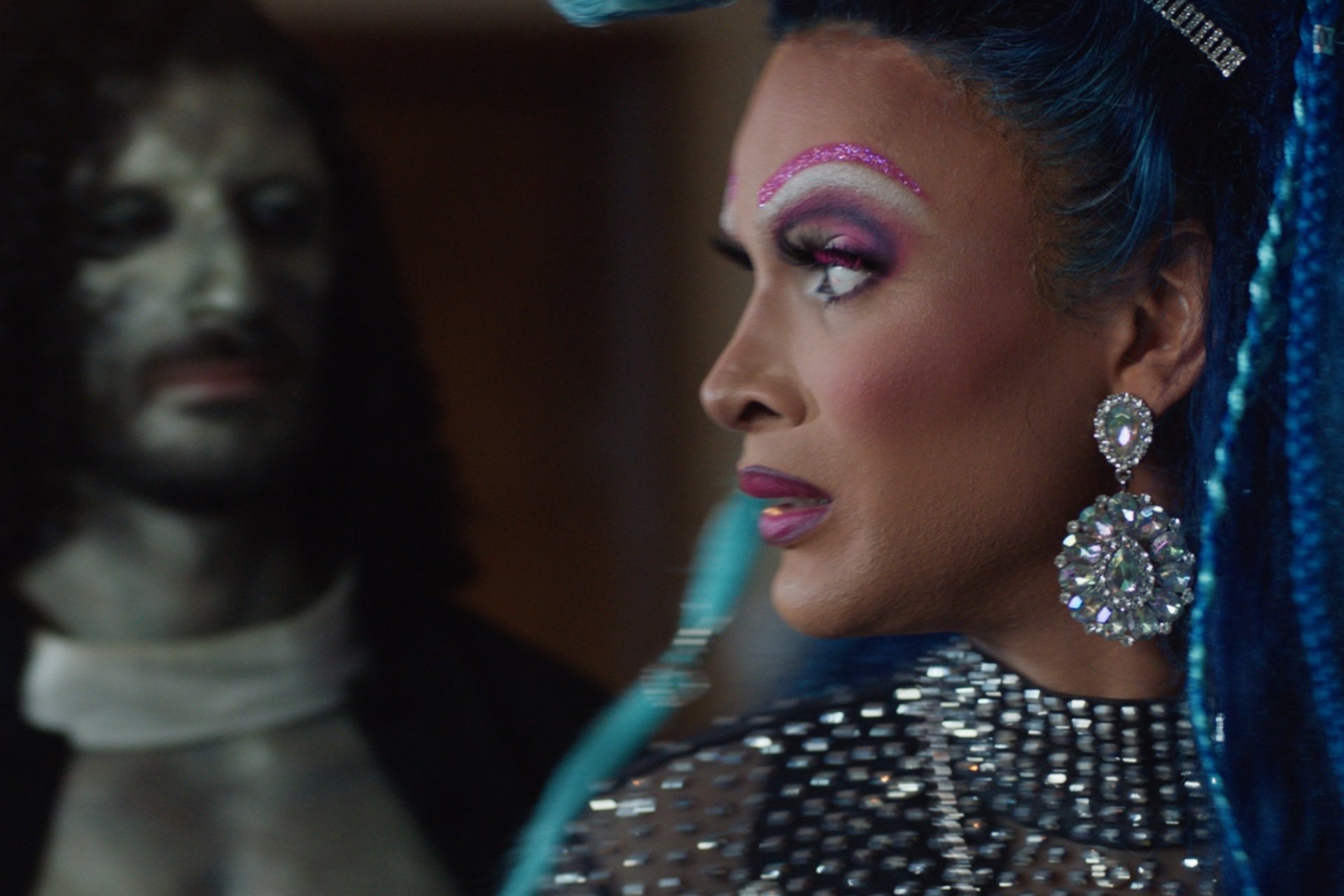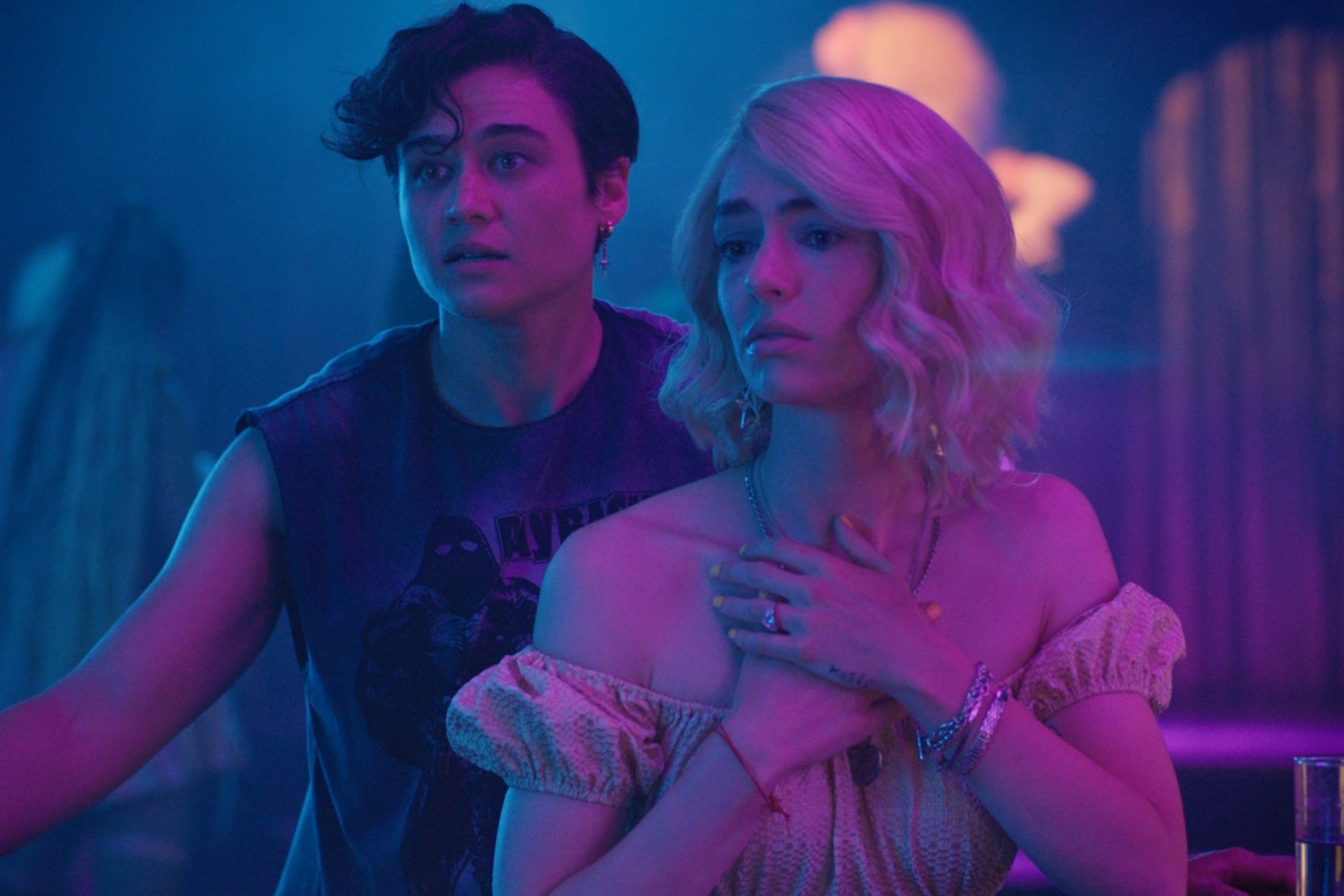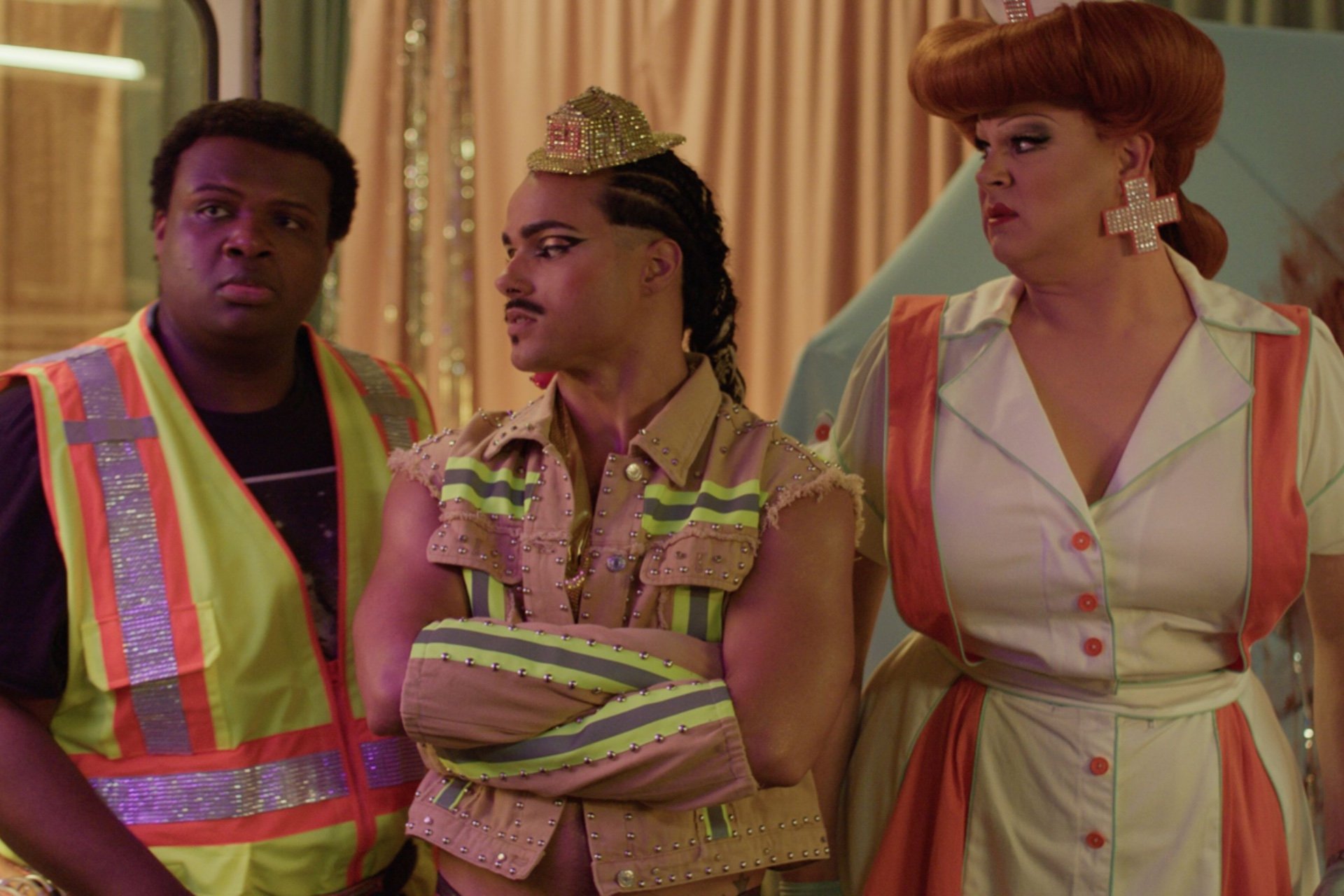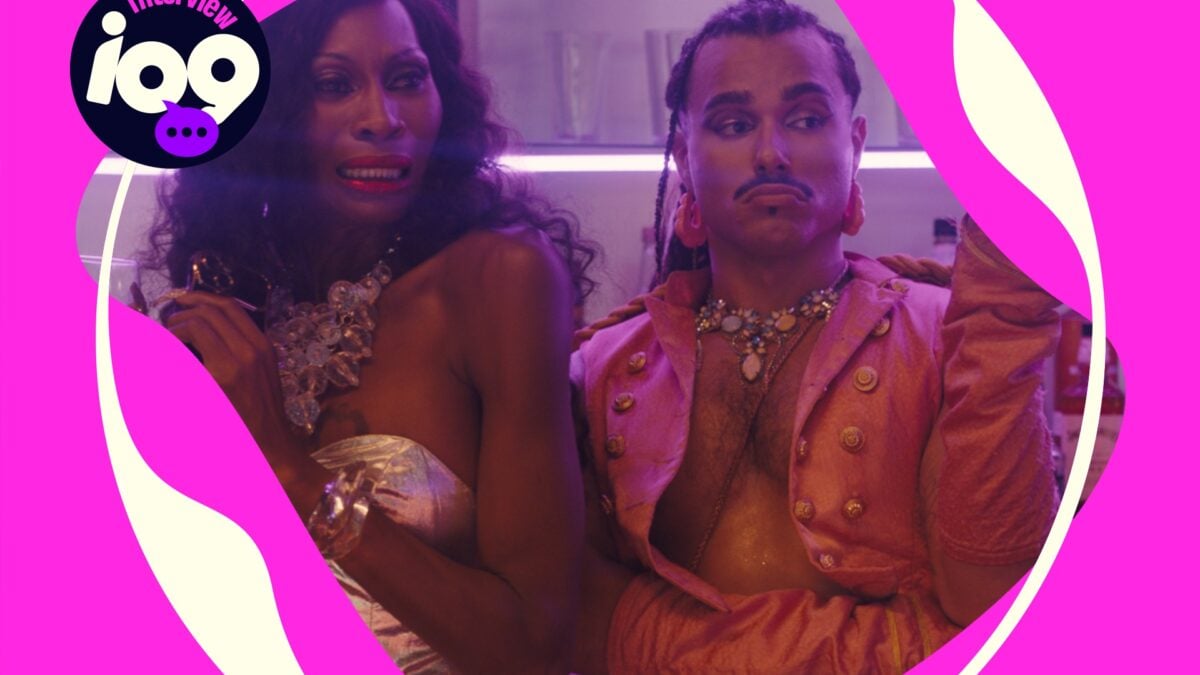What if the zombie apocalypse broke out in Brooklyn—and infiltrated the queer nightlife scene? That’s the very fun and sparkle-infused premise of Queens of the Dead, which opens this week and is directed by Tina Romero—yes, the daughter of zombie movie legend George A. Romero.
io9 talked to Tina Romero all about her debut feature, including what it’s like carrying on her father’s splattery legacy and the importance of seeing joyful queer representation onscreen.
Cheryl Eddy, io9: Growing up with George Romero as a dad, how did that affect your perception of zombie movies?
Tina Romero: I tell people I sat on a zombie’s lap before I met the mall Santa. Zombies were just like a fact of life. Like, Santa Claus exists and zombies exist, and that’s just how it is. I also say that I’m a kid who grew up on Pippi Longstocking and Bye Bye Birdie and West Side Story and ‘80s Disney movies, but then I would tiptoe past a terrifying poster on the way to the bathroom at night or Fluffy’s crate from Creepshow. So my world has always been a very strange mashup of dark and light.
I think that is at the core of my creativity. I’m an edgy cheeseball, and I like things that are light and playful and colorful and also have a bit of a gory edge. And my dad was very much the same. He made some dark, nihilistic, scary movies, but he was such a gentle giant, and he also loved the cheesy stuff. We watched a lot of movies together. That was our primary form of bonding. And he would unabashedly weep when he was moved. And I think that really impacted me and showed me the power of movies, the power of film to move people. That’s what I always picked up on: movies can move people and they can provoke real-life empathy. That was my guiding light as far as what I wanted to do with my life: I wanted to move people with movies.
io9: Was there any hesitation about making your feature film debut a zombie movie because you knew people would immediately compare you with your dad—or was that sort of the reason why you wanted to make a zombie movie first?
Romero: I think it’s both. As [Katy O’Brian’s character] Dre says in the movie, it’s always both. Certainly there was some hesitation, big shoes to fill, and fear of comparison, which is why I didn’t want to touch the genre unless I could do it in a way that felt authentically me. So when the concept came to me, it was just a very full-body yes. The idea of getting into the zombie genre through the lens of queer nightlife just felt like, this is exactly how I want to introduce myself as a filmmaker because this is a world that I know and people that I care about; I can tell [this] story authentically.
 Julie J and Ahmad Maksoud in ‘Queens of the Dead.’ © Courtesy of Shannon Madden. An Independent Film Company and Shudder Release.
Julie J and Ahmad Maksoud in ‘Queens of the Dead.’ © Courtesy of Shannon Madden. An Independent Film Company and Shudder Release.
And I love zombies; I know zombies; I grew up with zombies. So let’s mash up these worlds, and let me introduce myself as my own filmmaker while getting to also carry forward the monster that my dad created into 2025 with a female perspective, with a queer perspective. It just felt really right. Once the idea hit me, I knew that this was the perfect first feature for me.
io9: Queerness has been present in horror movies since horror movies began, though until the last few decades it was more subtext and suggestion. Queens of the Dead is very overt, of course. How does it feel to be carrying on that legacy and getting to be very free about it?
Romero: Oh, it feels incredible. I’m so excited that Shudder and IFC are putting this movie out in 2025. It feels like such an important time to, as you said, like it’s not subtext, it’s out there. We are here; the queers are here. We’re fighting zombies, we’re surviving, which is very much how the world feels right now.
And I’m really proud of the fact that this isn’t a movie that is showing queerness in a bleak way. It’s celebratory. It’s joyful. I feel like that’s what we need as queer people right now: we need to celebrate ourselves and we need to have some fun. And we need to feel the joy. So it feels incredibly important to me to be able to do this. My dad’s movies [had] a history of representing marginalized communities. And I’m so proud that I can, in 2025, do this for the queer community through the Romero zombie monster.
I hope this is a place where people can come and feel celebrated instead of erased and have a little reprieve from the fucking news cycle that just every single day is so scary. It is a horror film, but it’s also lighthearted. I wanted to make a film that people left the theater feeling a little hope in their heart and a pep in their step and a little fighting spirit. Because we have to keep fighting, and we have to stick together as a community and get through this, whatever this is.
io9: George Romero’s movies always had social commentary front and center; for instance, Dawn of the Dead’s shopping-mall zombies and consumerism. Queens of the Dead definitely seems to be making a statement about social media: influencers, dating apps, Snapchat, being too online, and being overly connected to our phones. What made you want to zero in on that theme?
Romero: Oh, because I am just so freaked out about how my own brain has changed in the, whatever, 11 years that it’s been since I’ve had a smartphone. I feel it. I feel my brain changing. When I go to open Candy Crush on the train without even making that choice, it really freaks me out. I feel like it’s sucking my attention. It’s changing the ways that we interact—just the anxiety it provokes. It’s been bugging me for a long time, and it really does feel like when you walk around the streets of New York, everyone’s a phone zombie. It’s happening. We are all phone zombies out here.
[The theme] felt very natural to me. We wanted to stick to the Romero zombie monster rules: they are slow, they do not run. One bite turns you. You have to take out the brain to defeat the monster. And then I wanted to add this little thing, which I know my dad would have approved of, which is that they’re still responding to their devices.
I believe that we would still be responding to our devices in in the event of a zombie apocalypse because it’s innate. It’s not a choice. It’s a muscle thing. So that was very important to me. And also, I think that phones—as much as they are a tool, and there are plenty of good things that have come out of connecting online and finding community online—I also think they are separating us in a whole entirely new way. I think it’s causing more tension and causing more fighting. That’s also something I wanted to dig into with the character of Barry [played by Quinn Dunn-Baker]. Barry, the brother-in-law, is on very different podcasts and very different algorithms but ultimately has a lot more in common with this group of people than he realizes. And I think that’s kind of the case for all humans right now: we’re more mad at each other online than we need to be.
 Katy O’Brian and Jack Haven in ‘Queens of the Dead.’ © Courtesy of Shannon Madden. An Independent Film Company and Shudder Release.
Katy O’Brian and Jack Haven in ‘Queens of the Dead.’ © Courtesy of Shannon Madden. An Independent Film Company and Shudder Release.
io9: The movie plays into zombie movie tropes—the sheltering in place, the weapons-gathering scene, and the “head shot” directive—but its setting and characters bring a new perspective. How conscious were you of including those familiar moments and aiming to subvert them?
Romero: I thought a lot about, okay, people are coming to this probably having seen a zombie film. So we don’t necessarily need to review all of the rules. But how can we remind people what they are while also treating the audience with the respect of, like, “You probably know what goes on in a zombie movie”? So there was a bit of a dance around how much we wanted to treat the audience as if they knew nothing or assuming most people would know about a zombie film and the rules of that.
It’s fun to play with the tropes and to queer them, you know? One of the first things I wanted to do was flip the script as far as the motley crew goes. Instead of having the token gay, we wanted to have all queer people with the one straight guy instead, and I love that. I think it really lends itself to a fun ride. And queer people are the funniest, most fun, most resilient, strongest, and most bound to survive. So it all felt so right to me.
And I personally think it’s very boring to kill zombies with guns; it’s so easy. So from the beginning, I was psyched about the concept of DIY weapons. What do they have in the club that they’re using to make armor? What are they fighting these zombies with and what does their armor look like? Because I do think drag in many ways is like armor. David Tabbert, the head of costumes, and I started talking about [the costumes for the final showdown] years before we started shooting. Like, what do their final showdown [outfits] look like and how are they both armor and drag?
 Jaquel Spivey, Tomás Matos, and Nina West in ‘Queens of the Dead.’ © Courtesy of Shannon Madden. An Independent Film Company and Shudder Release.
Jaquel Spivey, Tomás Matos, and Nina West in ‘Queens of the Dead.’ © Courtesy of Shannon Madden. An Independent Film Company and Shudder Release.
io9: The look of the zombies is unlike anything I’ve seen before—they’re metallic and glamorous, which obviously suits the movie’s themes. What went into coming up with the monster make-up?
Romero: I think zombies are often so butch. They’re wearing jeans, they’ve got the gross rotting flesh. And I just knew that wasn’t right for this film. If we were gonna do this in the queer nightlife world, we had to make the zombies fabulous. So from the beginning I knew I wanted to put glitter in the blood and Christina Grant, head of makeup, really got the assignment right away.
I love the zombies in Dawn of the Dead; I love that they’re just painted green. I think that there’s something to that. I think you can trust your audience to be like, “In this world, this is what zombies look like. Come along for the ride.” That’s what my dad did in Dawn of the Dead, and I wanted to sort of expand upon that.
So we found the perfect shade of green, and then we found the perfect metallic shimmer to layer on top of that. We worked with our prosthetic mold maker to ensure that the masks left ample room for there to also be a fabulous eyeshadow look. We wanted to make sure that the cheekbones were giving cheekbones, because we wanted to layer glam makeup with the gore. That very much on the mood board from the beginning, the concept of glam gore.
Also, how can that invite people into this movie who maybe would be hesitant to go to a zombie flick? In this case, there’s some glam. There’s some glitter in the blood. Come over to this movie. You’re going to have a good time. It’s not going to be too gross. And it also just feels spiritually right for the world of queer nightlife. These zombies are freshly dead on a Saturday night in Bushwick. They’re wearing going-out looks.
io9: Last up, I have to ask you about Tom Savini’s cameo.
Romero: There are two really fun Romero cameos! In the hospital. Gaylen Ross from Dawn of the Dead is the doctor that bumps into Sam [played by Jaquel Spivey] in the hallway.
io9: I didn’t catch that one. That’s amazing!
Romero: Isn’t that fun? It’s an ensemble cast; there are not a lot of speaking roles that are outside of the main group. And I really wanted to have some fun Romero universe cameos. And Tom was—I did have to ask him more than once because he was very, he’s a busy guy. But he ultimately was like, “Yeah, I’ll do this for you.” And I am thrilled that he plays the mayor of New York City at a party. We shot it on Zooms and I think he’s the perfect choice. What can I say? It’s so fun that there’s a Tom Savini cameo in this movie. Also, he and his partner, Jason Baker at Callosum Studios, made the zombie baby puppet.
io9: Almost a third cameo!
Romero: Exactly, exactly.
Queens of the Dead opens October 24; you can check the film’s website to see where it’s playing near you.
Want more io9 news? Check out when to expect the latest Marvel, Star Wars, and Star Trek releases, what’s next for the DC Universe on film and TV, and everything you need to know about the future of Doctor Who.

